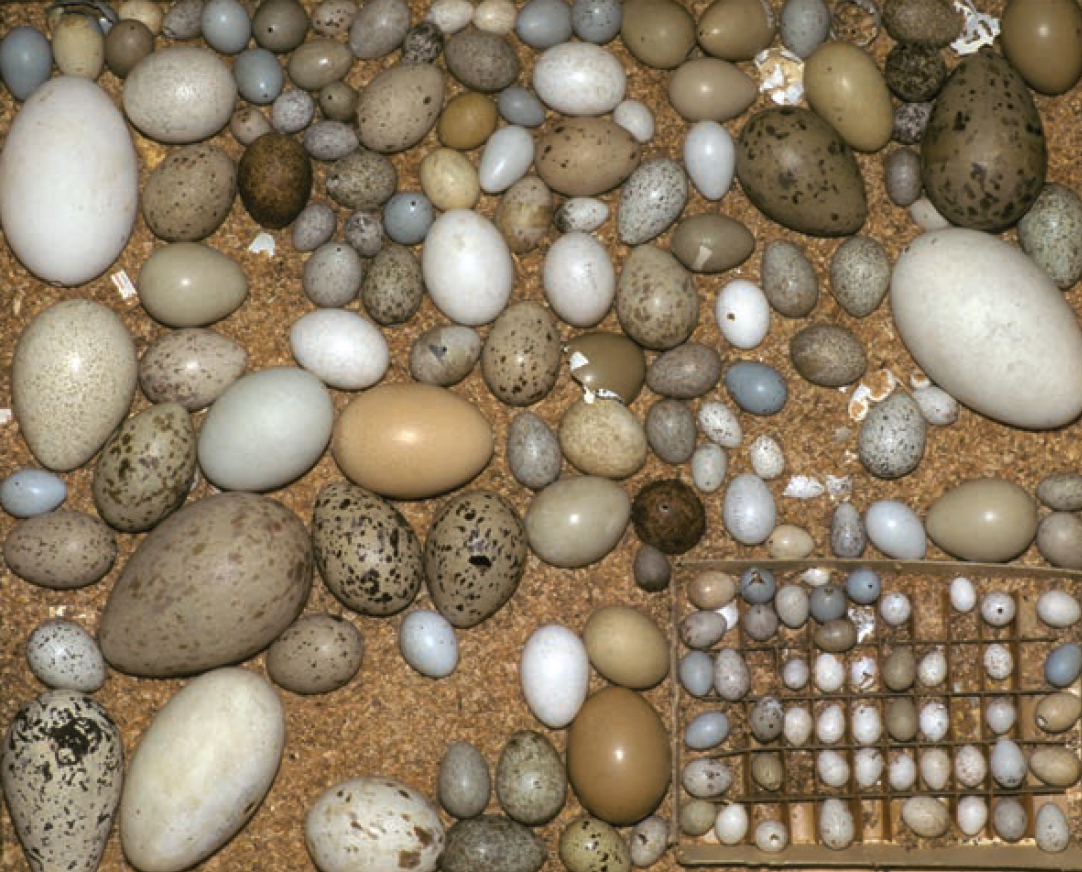40 : Egg collection
1895
An egg collection is perhaps the poor man’s mineral and gem drawer, and it is easy to see the attraction of the intricately patterned ovoids. However, such collections are indefensible and illegal in the modern age, when many bird species are declining.
In an age of awareness of the rapidly declining populations of many bird species, those who indulge in the collecting of wild birds’ eggs are now viewed harshly, and held to account by law. However, in the 19th century the quasi-science of oology, along with shooting, was one of the few ways in which early bird enthusiasts could get closer to and understand their subjects.
While the beauty of birds’ eggs inspired much acquisitiveness, there was originally a scientific purpose to many collections, enabling the accumulation of research collections in museums for use in studying the variation and structure of the external part of birds’ reproductive mechanisms. The Natural History Museum retains some 610,000 eggs in its collection, though that figure is surpassed by more than 800,000 eggs at the Western Foundation of Vertebrate Zoology in California, this quintessentially British practice being exported to the United States in the late Victorian era.
Although egging is often regarded as the habit of a bygone age of naturalists, and condemned by the British Ornithologists’ Union back in 1908, it shouldn’t be forgotten that in more naïve times in the 20th century, even some of the older generation of today’s active birders first expressed their interest by stealing the clutches of local common birds, and accruing at least a small collection.
Many tree-climbing, apple-scrumping, bruise-kneed small boys learnt that the eggs should be ‘blown’ to prevent the yolks from spoiling. This involved using a small thorn or drawing pin to make a tiny hole in the more pointed end of the egg and a slightly larger hole in the base of the egg; the pin or thorn was pushed into the membranes and yolk repeatedly to break it up, and then the lips or a straw would be gently placed against the smaller of the two holes and the contents gradually blown out. Latterly, an acid solution is often put into the eggs to dissolve the embryo, as egg theft cannot be timed precisely with the earliest part of the bird’s laying cycle.
The ease with which a collection could be self-started meant that by the mid-20th century most collectors were literally amateurs, and willing to take quite severe risks to obtain a rare egg, though the value of the actual eggs was no longer particularly high. The Protection of Birds Act 1954 made it illegal to collect eggs of the majority of British species, and it became against the law to even possess wild bird eggs after the passing of the Wildlife and Countryside Act 1981. In Britain, offences against these laws carry a maximum fine of £5,000 and a possible sentence of six months. These changes in the law and a growing awareness of the conservation implications of the activity undoubtedly affected its popularity, but for many the advent of good-quality, affordable modern optics provided a more acceptable means of getting close to nature.
Those remaining practitioners could be said to operate in a perverse parallel to mainstream birders, and a few are even birdwatchers themselves. The attractions of ‘egging’ are apparent in that it provides excitement, subterfuge, expertise and competition, and covertness is always attractive to a certain segment of society. Eggers have their own club in the Jourdain Society, named after the British ornithologist Rev. Francis Jourdain, though the aims of at least some of their members who have convictions for egg theft or possession are somewhat more acquisitive than study alone. Bird eggs are certainly beautiful and varied objects, often hard to obtain and fragile and precious to hold.
Many of the egging old guard are unashamed and openly documented in The Egg Collectors of Great Britain and Ireland: an Update by A C Cole and W M Trobe (Peregrine Books, 2011), and many also have maintained membership of the Jourdain Society to this day. One notorious egg thief of the modern era, Colin Watson, died in 2006, shortly after falling from a larch after investigating a nest; he was once accused of attempting to cut down a tree containing an Osprey’s eyrie with a chainsaw. The RSPB has a list of about 300 extant egg collectors and clubs, though not all can be proved to be currently active.
EDITOR’S NOTE: the date for this object, and therefore its correct place in the book’s running order, is somewhat arbitrary, but nevertheless appropriate. Most objects bear the year of date of first use or invention, but it is difficult to ascribe a precise date to the first ‘oological’ egg collection in the sense intended here. So 1895 has been chosen to represent a time when egg-collecting was popular on both sides of the Atlantic.
